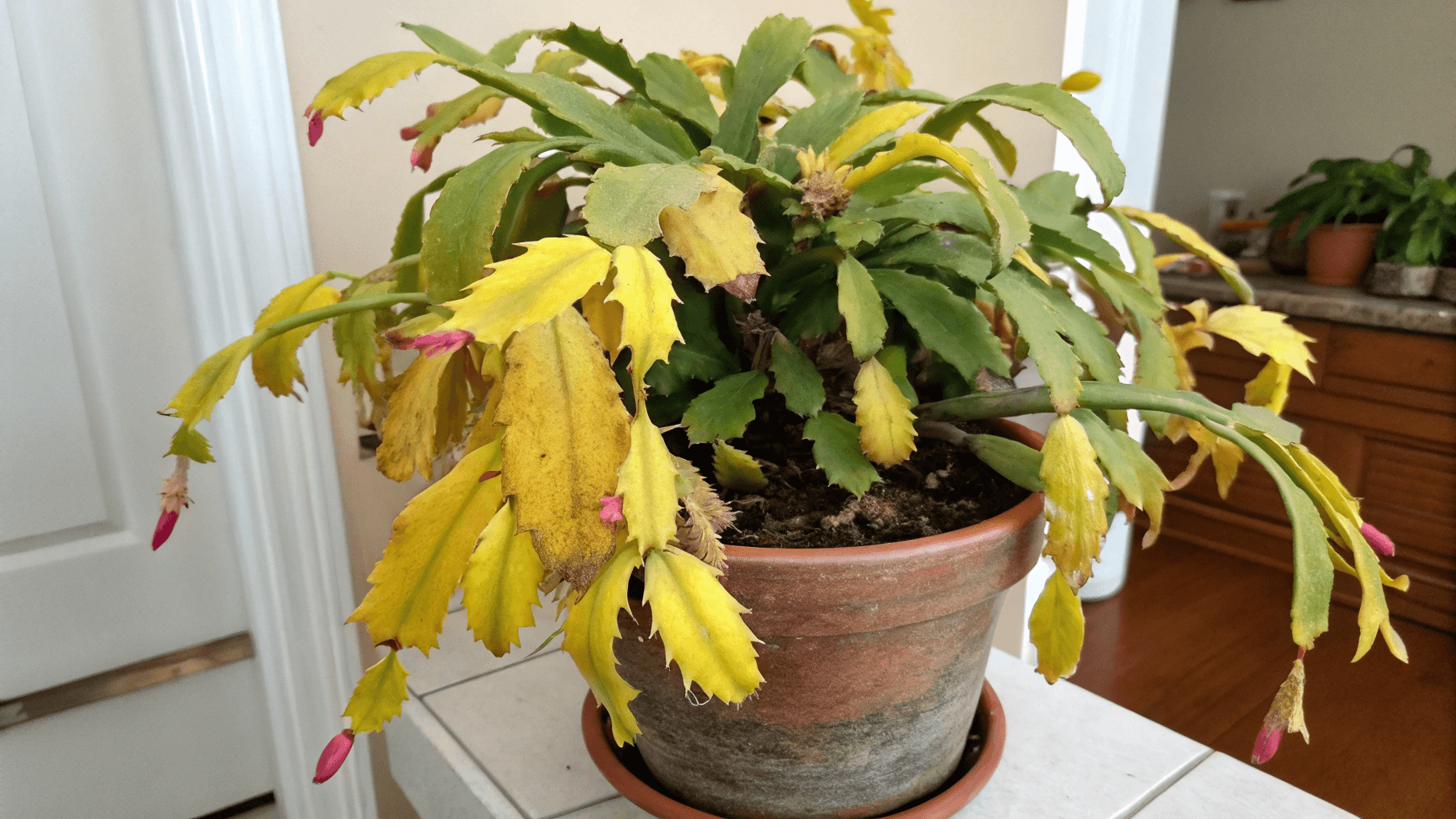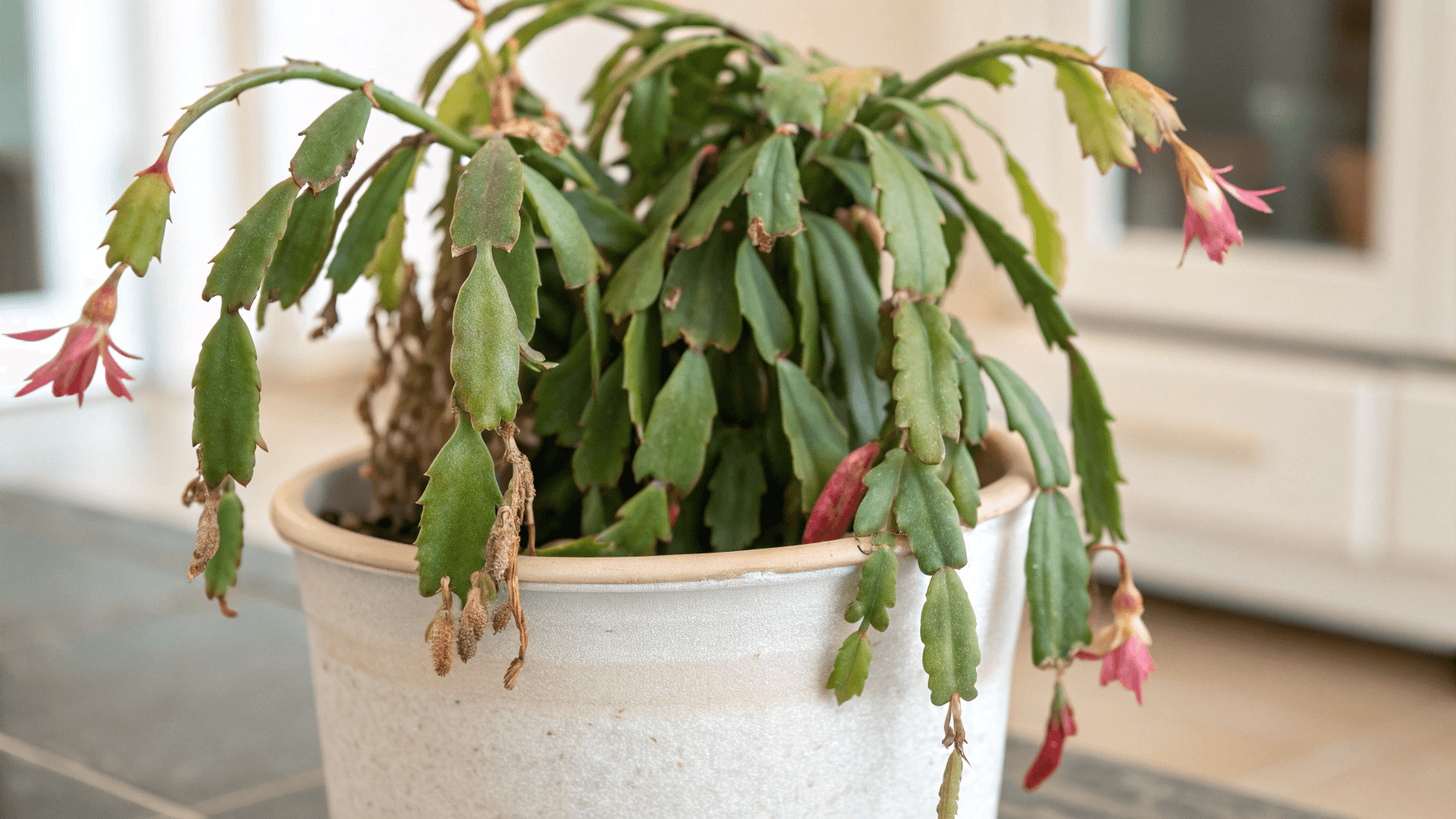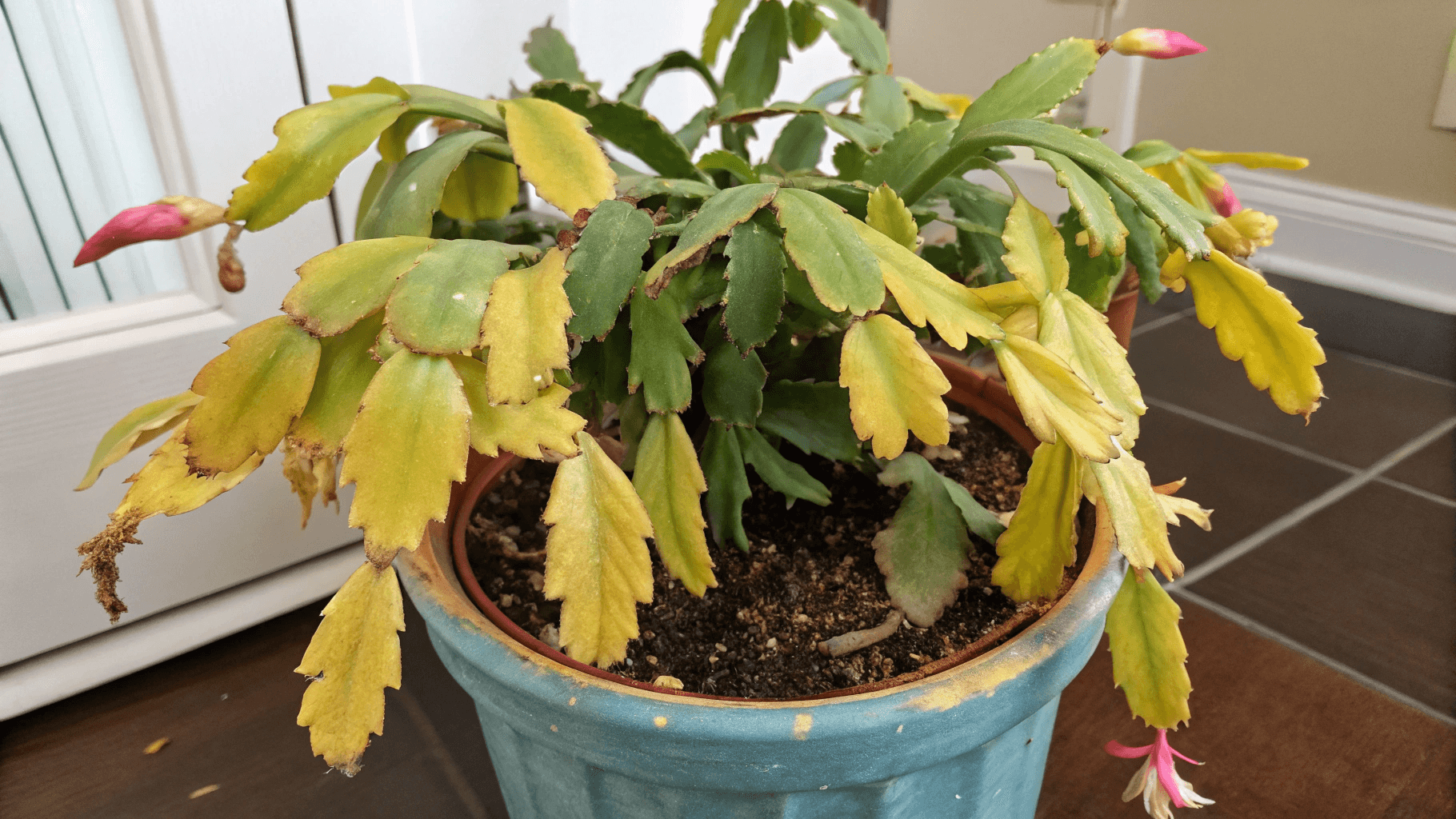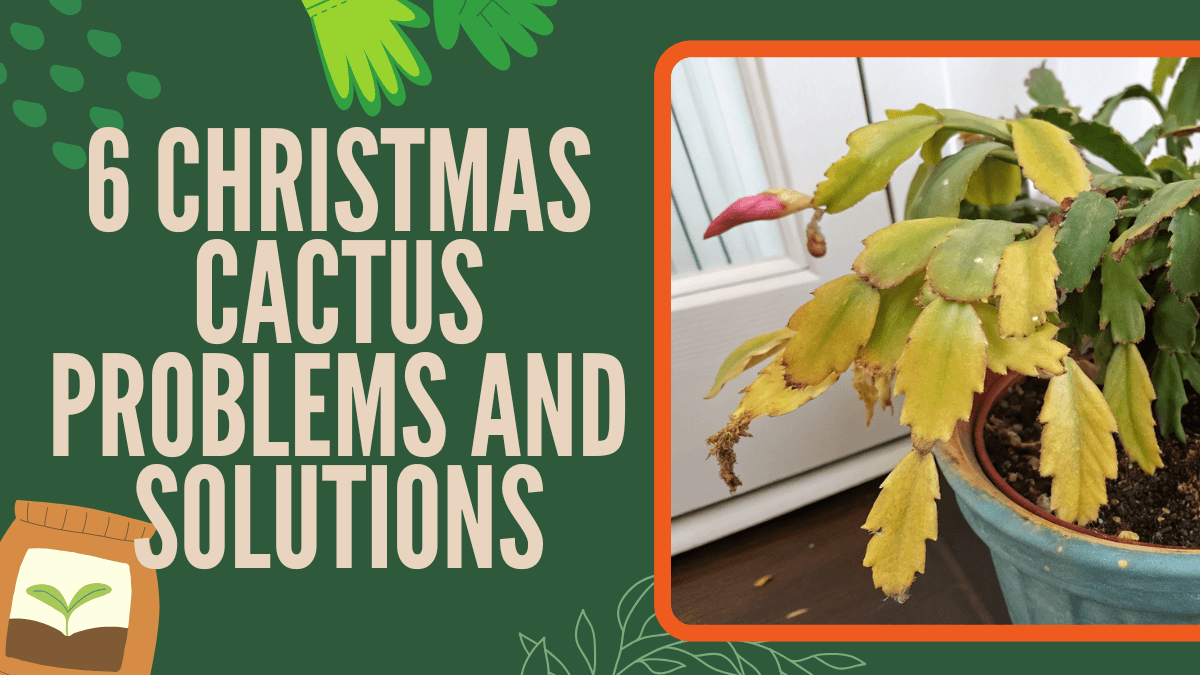If your Christmas cactus isn’t looking its best, the cause is almost always water or light, two things this plant depends on but reacts quickly to when they’re out of balance. Whether the leaves are turning yellow, stems are getting floppy, or something just “feels off,” the good news is that most issues are fixable once you understand what your plant is trying to tell you.
Below, we’ll walk through the most common Christmas cactus problems, how to diagnose them, and the exact steps to bring your plant back to full health.
Yellow Leaves
Yellowing segments are one of the first distress signals a Christmas cactus sends out. While this can happen for several reasons, the underlying cause is almost always stress, usually from water, lighting, or soil.

Common Causes
1. Overwatering
This is by far the most common issue. Christmas cacti store moisture in their segments, so constantly wet soil prevents oxygen from reaching the roots. As the roots suffocate, the plant redirects energy away from its leaves, causing them to yellow.
2. Too much direct sunlight
These plants are native to shaded, humid forests. A sunny windowsill, especially south-facing, can scorch the leaves, bleaching them yellow.
3. Nutrient deficiency
Old potting soil loses nutrients. If your plant hasn’t been fertilized in over a year, it may show yellowing or faded growth.
4. Pot bound or poor drainage
Compacted soil holds water too long, while pots without drainage trap moisture around the roots.
Solutions
• Check the soil moisture by inserting your finger an inch deep. If it feels wet, hold off watering until it’s nearly dry.
• Improve drainage using a cactus or succulent mix blended with bark or perlite.
• Move the plant to bright but indirect light; east-facing windows are ideal.
• Feed lightly during the growing season (spring to early fall) using a balanced, diluted liquid fertilizer every 3-4 weeks.
Limp or Drooping Cactus
If your Christmas cactus suddenly looks defeated, segments hanging, stems limp, it’s usually reacting to environmental stress.

Common Causes
1. Underwatering
The plant becomes dehydrated, causing segments to wilt and shrivel.
2. Overwatering
Oddly enough, too much water can also cause limpness because root damage prevents the plant from absorbing moisture.
3. Temperature shock
Cold drafts or sudden heat can stress the plant.
4. Repotting shock
Disturbing the roots can cause temporary drooping.
Solutions
If dry:
- Give it a slow, deep watering until excess drains out.
- Resume a consistent schedule (watering when the top 1-2 inches of soil dries).
If wet:
- Let the soil dry out partly.
- If roots smell sour or feel mushy, repot immediately (see Root Rot section below).
If temperature-related:
- Keep it between 60-70°F (15-21°C) and away from vents or exterior doors.
A limp Christmas cactus almost always rebounds once the underlying stress is corrected.
Wrinkled Segments
Wrinkled leaves signal a hydration imbalance, but the trick is figuring out which direction.

Two Opposite Causes
- Underwatering: Segments lose firmness, wrinkle, and take on a slightly dull appearance.
- Overwatering leading to root damage: Even though the soil is wet, roots can’t absorb moisture, so the plant behaves as if it’s starving for water.
- Soil very dry? – Underwatered
- Soil consistently wet? – Overwatered or root damage
- Plant hasn’t been repotted in many years? – Compacted soil prevents proper moisture absorption.
Solutions
For underwatering:
- Water thoroughly and consider switching to a more moisture-retentive mix if it dries out too fast.
For overwatering or root issues:
- Remove the plant from its pot.
- Trim off any mushy or black roots.
- Repot in fresh, airy soil.
- Water lightly for the first week.
Red or Purple Leaves
A Christmas cactus with reddish or purplish segments is telling you it’s stressed, but also showing you exactly how.

Common Causes
1. Too much sun
Direct sunlight triggers a protective pigmentation (anthocyanin), turning leaves red or purple.
2. Nutrient deficiency
Lack of magnesium or phosphorus can cause purplish tones in older segments.
3. Cold temperature stress
Exposure to temps below 50°F (10°C) can alter pigment.
4. Underwatering
Water stress may also cause darkened hues.
Solutions
- Move the plant to filtered light – sheer curtains work well.
- Resume regular watering if the soil is extremely dry.
- Test the soil age, if it’s more than 2-3 years old, repot or fertilize with a magnesium supplement (Epsom salt at 1 tsp per gallon once a month during spring/summer).
- Stabilize temperature away from cold drafts.
The color should return to normal within a few weeks.
Root Rot
Root rot is the most serious Christmas cactus problem, but it’s also one you can catch early if you know what to look for.

Early Warning Signs
- Soil stays wet for a long time
- Musty or sour smell from the pot
- Yellowing or limp growth
- Mushy, dark brown roots
- Segments falling off at the slightest touch
Rescue Steps
- Remove the plant from the pot immediately. Gently loosen the soil and inspect the roots.
- Trim all damaged parts. Healthy roots are pale and firm. Remove anything black, mushy, or foul-smelling.
- Let the plant air-dry for several hours. This helps prevent further infection.
- Repot into fresh, fast-draining soil. Use a mix of cactus soil + perlite + orchid bark to mimic airy rainforest conditions.
- Water sparingly for the first 1-2 weeks. Light moisture is fine, but no soaking.
- Provide bright, indirect light. Your cactus will grow new, healthy roots in time.
If the root system is too far gone, skip ahead to the propagation section.
Pest Issues
While Christmas cacti aren’t typically pest magnets, certain conditions, usually high humidity and overly wet soil, can attract unwanted guests.

1. Mealybugs
Symptoms
- White, cotton-like clumps
- Sticky residue (honeydew)
- Yellowing or distorted new growth
Solutions
- Dab bugs with a cotton swab dipped in isopropyl alcohol.
- Shower the plant to dislodge hidden clusters.
- Apply neem oil weekly until they’re gone.
- Isolate the plant from others during treatment.
2. Fungus Gnats
These aren’t directly harmful to your cactus, but their presence signals wet, poorly-draining soil.
Solutions
- Let the soil dry out between waterings.
- Use sticky traps to catch adult gnats.
- Treat the soil with a biological control like Bacillus thuringiensis israelensis.
- Add a layer of sand or fine gravel to the top of the soil to discourage egg-laying.
Solving the moisture issue almost always eliminates gnats.
When to Save vs. When to Propagate
Christmas cacti are incredibly resilient. Even when a plant looks hopeless, you can often save it or at least save parts of it.
Save the Plant If
- Some roots are still firm and pale
- Stems are mostly green
- The plant still produces new growth
- Only one section shows symptoms
In these cases, repotting and correcting watering habits usually bring the plant back.
Propagate Instead If
- Most roots are rotted
- Segments fall off easily
- Stems are mushy or collapsing
- The plant shows no signs of recovery after repotting
Propagation is incredibly easy with Christmas cacti, and sometimes starting fresh is the quickest path to a healthy, thriving plant.
To grow new plants, simply:
- Twist off a healthy 2-4 segment cutting.
- Let it callous for 24 hours.
- Root in water or soil.
For a full walkthrough, see the propagation guide linked in the conclusion.
Conclusion
Most Christmas cactus problems come down to understanding what the plant needs: moist but not soggy soil, soft filtered light, moderate temperatures, and occasional feeding. Once you dial in those basics, it’s surprisingly easy to keep your cactus thriving and even reblooming every year.


 ChatGPT
ChatGPT
 Perplexity
Perplexity
 Claude
Claude

Leave a Reply